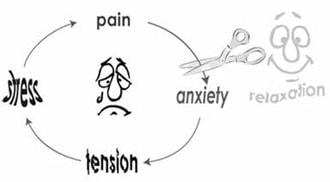|
“If only I knew then what I know now – how different it all might have been.... Most of us have had times in our lives that cause this phrase to resonate around in our heads causing a plethora of feelings, occasionally positive but more often negative: inadequacy; regret sorrow; sadness. I wonder for many women if this rings most true with their experience of childbirth. I know it does for me. In many ways society sets us up to expect childbirth to be horrifically painful and of a woman not being able to cope. We are bombarded with images in the media of childbirth being a medical event involving much screaming, shouting, panic and above all a painful experience that requires drugs to take the pain away. Then to top it all friends, family and sometimes complete strangers are desperate to impart their bad birth experiences to you as soon as they know you are pregnant. To hear the “gentle birth” stories - the stories where babies are born peacefully in an atmosphere of calm and where the power of childbirth is embraced you need to be inquisitive. You need to actively seek them out. Many of us only search out these “gentle birth” stories second time around when the “if only” echoing in our minds drives us to understand better and take control. What do I know now? What’s my “if only”?It is that the "pain" of labour is a normal side-effect of a natural process. The pain is simply the consequence of a woman’s body working hard and a sensation that tells you all is going well – whereas in most other contexts of our lives pain is seen as negative and treatable with a variety of drugs and interventions. By understanding the physiology of labour and the intricate interplay between you, your baby and your hormones helps to break the “fear - pain cycle” and allows you to work with the pain, decreasing fear and making the sensations of childbirth more bearable and labour more efficient and shorter. the "pain" of labour is a normal side-effect of a natural process
So, what is available to help you take control of your labour and minimise the chances of an “if only” birth experience? The good news is there are many things you can do do take control of your labour AND they are simple, logical, easy to master and involve: continuous emotional support, movement and position, labouring in water, breathing techniques, relaxation, massage, TENS. Couple these techniques with knowledge and information, you have a powerful alliance, enabling you to make informed decisions and be in control of your birth experience. SupportResearch has shown that it's important for women in labour to have emotional support. This means encouragement, reassurance, a trusted person to listen to you and just be there. For most women this would be their partner, for others it will be a friend or close family member. Making sure that you have the right person to support you will help you cope with the pain and discomfort of labour more easily. Studies (Cochrane 2017) have shown that with continuous birth support you are:
Continuous support could be provided by an independent midwife, doula or in Belgium a physiotherapist. Position and MovementGravity is your friend! It is a powerful force, so don't fight it. Staying upright keeps labour hormones flowing and gives your baby maximum room to manoeuvre. Movement – walking, swaying – also lends labour a helping hand. Being upright and mobile maximises your body’s ability to give birth and there are no downsides you are doing what comes naturally. Breathing and Relaxation Breathing and relaxation techniques are fantastic at reducing stress and helping you stay calm. They relieve tension in muscles and make sure oxygen is channelled to your hard working uterus and baby. Breathing techniques used during contractions can provide a focus that reduces the sensation of pain. Massage Massage releases tension and provides reassurance and comfort while at the same time encouraging the flow of birth hormones. It is non-invasive, can be started and stopped easily and involves your partner in your labour. WaterMost hospitals are able to offer you the chance to labour in water and it is possible if you choose to have a home birth. Water soothes pain and, in a large birthing pool, supports you, enabling you to glide into any position. A hot shower on your back or a warm bath at home can help too. Women who labour in water need fewer interventions and are less likely to need other drugs. It is a drug-free option and works well but sometimes it can slow down labour, particularly if you get in too early. You also need to make sure the water feels warm but not hot. Having an epidural or using a TENS are not possible in water. If you would like to actually go on to birth you baby in water you need to discuss it with your caregivers - gynaecologist or independent midwife and see if it is an option they are able to support. TENS (Transcutaneous Electrical Nerve Stimulation)A TENS machine is a small battery operated device that transmits mild electrical impulses to pads on your back The electrical pulses are thought to stimulate nerve pathways in the spinal cord which block the transmission of pain messages to your brain. On the plus side TENS can act as a distraction, with many women finding it effective in early labour, what’s more you are in control. You can move about freely and you may use the TENS at home, keeping it on when you go into hospital. There is some evidence that women using TENS are less likely to rate their pain as severe and women cope better with contractions. The downsides are that you will need your partner to help you place the pads on your back using it in water is a no and some may find the sensation irritating. Also you may need to remove the TENS if you have a CTG (cardiotocograph – a form of electronic monitoring of your baby). But, it is non-invasive and has no side effects for you or your baby. TENS machines are available to hire from the BCT. How do hypnobirthing techniques help break the fear-pain-tension cycle? Hypnobirthing is a powerful combination of all of the above. It is so much more than just a few relaxation and breathing techniques. Lots of simple, little things (you can't be doing complicated things when you are giving birth) and then practicing them. The more you practice how to quieten your mind and relax the more deeply relaxed you become and the easier it is to relax. So, you practice, practice, practice! When it comes to your baby's birthday you will be able to access the hypnobirthing tool box take out the right technique for you and use it with skill and understanding. Within a KG Hypnobirthing Course, we create space for you to release any fear you have accumulated about childbirth (breaking the fear-pain-tension cycle) and building confidence in your body to birth your baby. Hypnobirthing encompasses:
At the end of the day every labour is different and you should be able to choose whatever you need to help you work with the pain of labour. Give yourself a chance of avoiding the “if only” by:
KGH gives you the tools to achieve the best birth for you! Kate EllwoodMother, Wife, Hypnobirthing Teacher, First Aid Instructor and so much more... 
0 Comments
Leave a Reply. |
Kate EllwoodKG Accredited Hypnobirthing Teacher Archives
February 2024
|





